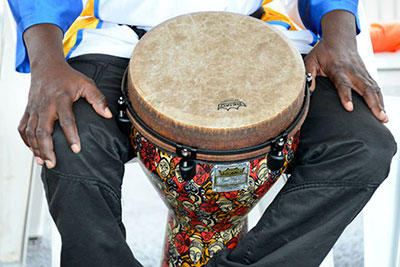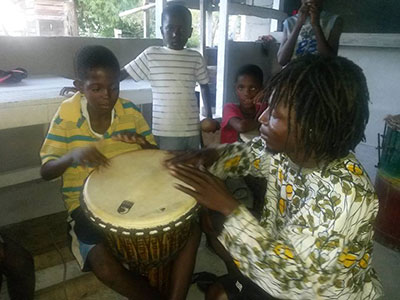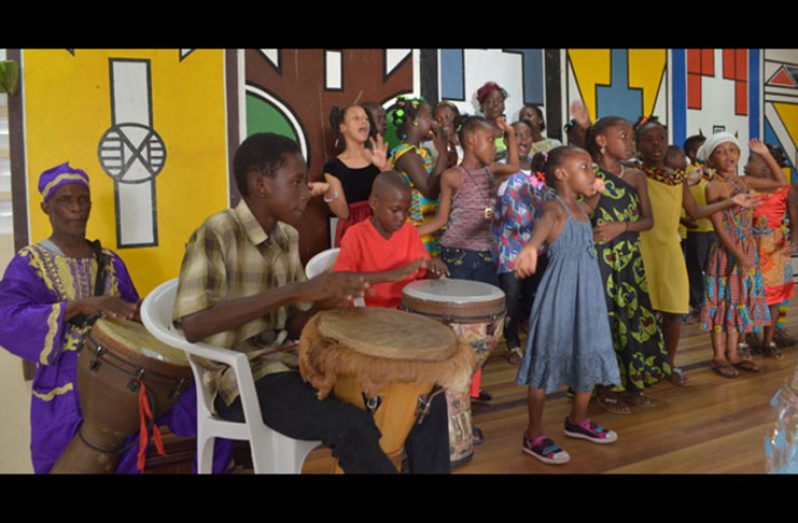– master drummers striving to preserve cultural art form
By Ravena Gildharie
MARK Cryus is a master African drummer who feels empowered by the ‘therapeutic’ and ‘sacred’ art form, which he strongly believes can help inspire positivity among the young

and upcoming generations, but only after the negative influences are removed from this aspect of the dynamic African culture.
“There is still a lot of negative influences associated with African drumming,” Cryus told the Pepperpot Magazine, adding that “I think this is why most of the youths are scared of it, and are shying away from this part of the African culture.”
Cryus, now age 51, is leader of the Otishka drummers, one of the country’s most popular drumming groups that was established some 30 years ago, and which has performed at many national events countrywide, and at several Caribbean Festival of Arts (CARIFESTA). He is a prominent drumming teacher and also formed the Diamond Drummers, a group out of the Diamond Special Needs School. This troupe also enjoys national exposure and participated in CARIFESTA XII in Suriname. Otishka has about eight regular performers while the Diamond group has about five.
Cyrus said the name Otishka derives from an African folktale of two brothers, Ozula, a negative sibling and Otiskha, the positive one. The drummer has participated in several traditional African Libation and Queh Queh ceremonies.

the Buxton Fusion School of Music
A resident of Bagotville, West Bank Demerara, where he was born and raised, Cyrus said he has been associated with drumming for almost all of his life, stemming from toddler stage when he took a liking to the beating of metal tins and cardboard boxes. By age five, he started formal drumming lessons as an entertainer in a nearby village’s dance school and youth group. He later joined dance/music schools in Georgetown, including the National School of Dance during the 1980s and where he developed much of his drumming skills.
“My experience has been tough over the years. I’ve heard people call drumming a lot of negative names, ‘obeah’ and ‘anta banta.’They see drumming as a bad thing, and I think that is because of a lack of experience and understanding of it,” Cryus said. He believes that once people get exposed to drumming and begin to understand the dynamics of the art form, there would be a better appreciation publicly, and a willingness among the youths to learn and preserve drumming.
He highlighted that the youths need to sensitise themselves about drumming and trace it back to their roots, so they can be able to adopt the art form and use it to identify with their African culture and traditions.
Identified a few years ago as a fading culture in Guyana, there have since been various initiatives to revive and preserve African drumming involving the government, international and non-profit bodies, private groups, individuals and the African Cultural and Development Association (ACDA).
Back in 2013, ACDA received a $1 million grant from the Cultural Centre of the Inter-American Development Bank (IDB), specifically to boost African drumming. Around the same time, young Guyanese musician, Orlando Primo, launched his African Drumming School, Majek Fingers, initially based at ACDA’s building. Though Primo relocated to the United States (U.S.) where he is advancing his drumming heritage, Majek Fingers yielded great success locally, and is even now building its own facility in Georgetown.
The emergence of young drummers
The school conducts classes regularly and attracts students ranging from five to 30 years old. Interestingly, most of the training sessions are led by young drummers including Akomo Patterson, age 24, who joined Majek Fingers four years ago. He explained that while Majek Fingers teaches the traditional African beats, the drumming sessions also integrate popular and modern Caribbean rhythms, thus creating an Afro-Caribbean style. The students are taught the use of several drums including congas, bongos, djembe, and doumbek.
Patterson said he started drumming at age six, and feels that the art form has a deeper effect beyond the African culture.
“It makes me feel very comfortable and I am pleased to be part of the process of teaching it to others,” Patterson stated. Aside from Majek Fingers, he conducts his own private drumming lessons targeting children ages three to eight.
“Unbelievable, right?” he posited, adding “But, you should see the energy of these kids…I have a three-year-old student who is really, really good. These kids are fast learners, you see.”
Patterson, who is currently preparing for a grand African drumming performance at CARIFESTA in Barbados, started playing the drums at age six. He learnt drumming from an uncle and was previously a member of the Otishka group.
“Okomo was my student and when he came to me and said he wanted to go with Majek Fiingers, I said ‘okay.’ That is what I always encourage them [students] to do, to move around, get exposure and learn new beats and so,” indicated Cyrus, who has taught scores of young drummers while still mastering his own skill.
He specialises in several styles of hand drumming and rhythms, including the congo, kumina or Shango, kumfa, masquerade or jonkunnu and vodhoo. He uses various types of drums too and even makes his own using wood and goat skins.
“People today are using all kinds of materials to make their drums. Some use PVC pipes, some use wood, some use the skins, while some use the fish plastic. It all depends on the effects and energy you get from whatever materials you use, and of course, how loud the sound is,” the drummer explained.
He personally prefers the use of the traditional wood and goat skin. From the truck of a tree, he carves his instrument and attaches the skin to create some of the most pulsating rhythms.
“I always liked the drums and it makes me feel good. Drumming can heal the body and the mind and it is a very powerful thing. I remember the Yoruba band singing, ‘drums make the world go around,’ and I truly believe that,” Cyrus stated.
The Buxton Fusion School of Music is another prominent music group led by Deodat Persaud of Mahaica and involving a large number of young drummers. It was formed in 2007 with a group of drummers from Buxton along with Persaud and the leader Marlon Adams. At that time, they called themselves ‘Together Brothers,’ and were initially involved in rehearsals and performances at Queh Quehs and other occasions in and around the village. The group performed at CARIFESTA in 2008 and later added the music school in 2011 as the focus expanded to teach children and others.
On his Facebook page, Persaud relates: “While living as a musician in London over a long period of time, I was fortunate to work with the master drummers from Ghana and Nigeria. Dealing with the elders, I began to learn the traditions of music and, importantly, the transition of music into a cultural norm and its impact on human development and on the nation as a whole.
On my return to Guyana, I set up a music co-operative based in Buxton in 2007. In 2009, three members from our group were invited to perform at the Commonwealth Heads of Government meeting held in Trinidad.”
There are smaller drumming groups in Essequibo, Berbice and Linden, where efforts are ongoing to keep African drumming alive through the ages.




.png)









